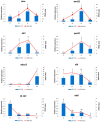Transcriptome Analysis of Larval Segment Formation and Secondary Loss in the Echiuran Worm Urechis unicinctus
- PMID: 31013695
- PMCID: PMC6514800
- DOI: 10.3390/ijms20081806
Transcriptome Analysis of Larval Segment Formation and Secondary Loss in the Echiuran Worm Urechis unicinctus
Abstract
The larval segment formation and secondary loss in echiurans is a special phenomenon, which is considered to be one of the important characteristics in the evolutionary relationship between the Echiura and Annelida. To better understand the molecular mechanism of this phenomenon, we revealed the larval transcriptome profile of the echiuran worm Urechis unicinctus using RNA-Seq technology. Twelve cDNA libraries of U. unicinctus larvae, late-trochophore (LT), early-segmentation larva (ES), segmentation larva (SL), and worm-shaped larva (WL) were constructed. Totally 243,381 unigenes were assembled with an average length of 1125 bp and N50 of 1836 bp, and 149,488 unigenes (61.42%) were annotated. We obtained 70,517 differentially expressed genes (DEGs) by pairwise comparison of the larval transcriptome data at different developmental stages and clustered them into 20 gene expression profiles using STEM software. Based on the typical profiles during the larval segment formation and secondary loss, eight signaling pathways were enriched, and five of which, mTOR, PI3K-AKT, TGF-β, MAPK, and Dorso-ventral axis formation signaling pathway, were proposed for the first time to be involved in the segment formation. Furthermore, we identified 119 unigenes related to the segment formation of annelids, arthropods, and chordates, in which 101 genes were identified in Drosophila and annelids. The function of most segment polarity gene homologs (hedgehog, wingless, engrailed, etc.) was conserved in echiurans, annelids, and arthropods based on their expression profiles, while the gap and pair-rule gene homologs were not. Finally, we verified that strong positive signals of Hedgehog were indeed located on the boundary of larval segments using immunofluorescence. Data in this study provide molecular evidence for the understanding of larval segment development in echiurans and may serve as a blueprint for segmented ancestors in future research.
Keywords: Echiura; Hedgehog pathway; Urechis unicinctus; segmentation; transcriptome.
Conflict of interest statement
The authors declare no conflict of interest.
Figures







Similar articles
-
Muscular Development in Urechis unicinctus (Echiura, Annelida).Int J Mol Sci. 2020 Mar 26;21(7):2306. doi: 10.3390/ijms21072306. Int J Mol Sci. 2020. PMID: 32225111 Free PMC article.
-
Morphological Observation and Transcriptome Analysis of Ciliogenesis in Urechis unicinctus (Annelida, Echiura).Int J Mol Sci. 2023 Jul 16;24(14):11537. doi: 10.3390/ijms241411537. Int J Mol Sci. 2023. PMID: 37511295 Free PMC article.
-
Transcriptional response to sulfide in the Echiuran Worm Urechis unicinctus by digital gene expression analysis.BMC Genomics. 2015 Oct 21;16:829. doi: 10.1186/s12864-015-2094-z. BMC Genomics. 2015. PMID: 26487380 Free PMC article.
-
The developmental transcriptome atlas of the spoon worm Urechis unicinctus (Echiurida: Annelida).Gigascience. 2018 Mar 1;7(3):1-7. doi: 10.1093/gigascience/giy007. Gigascience. 2018. PMID: 29618045 Free PMC article.
-
Transcriptome analysis of starch and sucrose metabolism across bulb development in Sagittaria sagittifolia.Gene. 2018 Apr 5;649:99-112. doi: 10.1016/j.gene.2018.01.075. Epub 2018 Jan 31. Gene. 2018. PMID: 29374598 Review.
Cited by
-
A chromosome-level genome assembly of the Echiura Urechis unicinctus.Sci Data. 2024 Jan 18;11(1):90. doi: 10.1038/s41597-023-02885-7. Sci Data. 2024. PMID: 38238346 Free PMC article.
-
Identification of the neuropeptide precursor genes potentially involved in the larval settlement in the Echiuran worm Urechis unicinctus.BMC Genomics. 2020 Dec 14;21(1):892. doi: 10.1186/s12864-020-07312-4. BMC Genomics. 2020. PMID: 33317448 Free PMC article.
-
Gotta Go Slow: Two Evolutionarily Distinct Annelids Retain a Common Hedgehog Pathway Composition, Outlining Its Pan-Bilaterian Core.Int J Mol Sci. 2022 Nov 18;23(22):14312. doi: 10.3390/ijms232214312. Int J Mol Sci. 2022. PMID: 36430788 Free PMC article.
-
Muscular Development in Urechis unicinctus (Echiura, Annelida).Int J Mol Sci. 2020 Mar 26;21(7):2306. doi: 10.3390/ijms21072306. Int J Mol Sci. 2020. PMID: 32225111 Free PMC article.
-
Echiuran Hox genes provide new insights into the correspondence between Hox subcluster organization and collinearity pattern.Proc Biol Sci. 2022 Sep 14;289(1982):20220705. doi: 10.1098/rspb.2022.0705. Epub 2022 Sep 7. Proc Biol Sci. 2022. PMID: 36264643 Free PMC article.
References
-
- Zhang Z.Q., Fan Q.H., Pesic V., Smit H., Bochkov A.V., Khaustov A.A., Baker A., Wohltmann A., Wen T., Amrine J.W. Animal Biodiversity: An Outline of Higher-Level Classification and Survey of Taxonomic Richness. Magnolia Press; Auckland, New Zealand: 2011. pp. 10–100.
-
- Hessling R. Metameric organisation of the nervous system in developmental stages of Urechis caupo (Echiura) and its phylogenetic implications. Zoomorphology. 2002;121:221–234. doi: 10.1007/s00435-002-0059-7. - DOI
-
- Nielsen C. Spezielle Zoologie. Teil 1: Einzeller und Wirbellose Tiere. Acta. Zool. 2008;89:179–180. doi: 10.1111/j.1463-6395.2007.00299.x. - DOI
MeSH terms
Substances
Grants and funding
LinkOut - more resources
Full Text Sources
Miscellaneous

